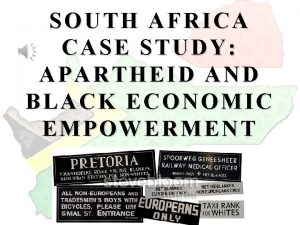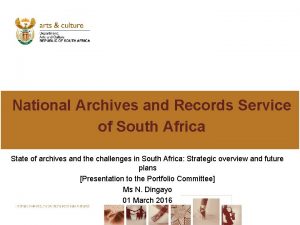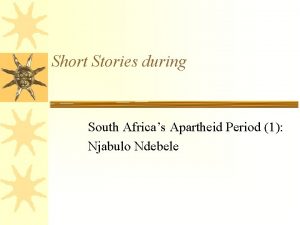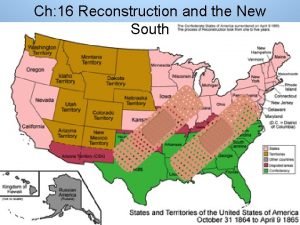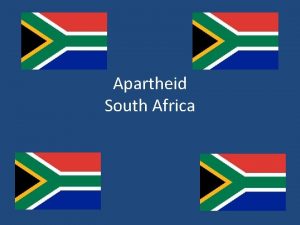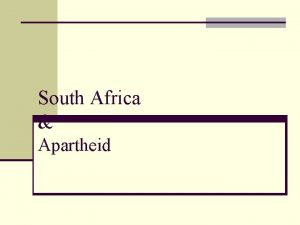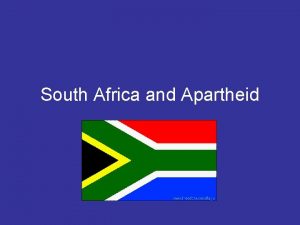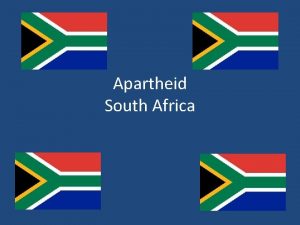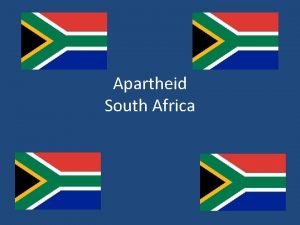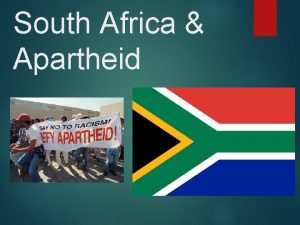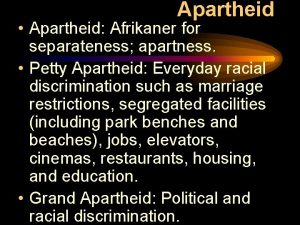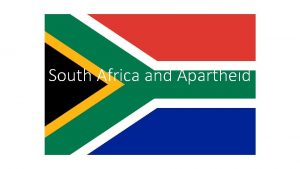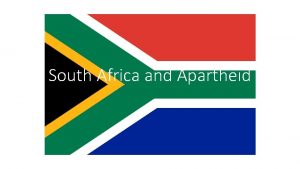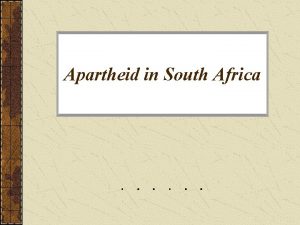South Africa Overview of Apartheid After the National












- Slides: 12

South Africa

Overview of Apartheid • After the National Party gained power in South Africa in 1948, its allwhite government immediately began enforcing existing policies of racial segregation under a system of legislation that it called apartheid. • Under apartheid, nonwhite South Africans (a majority of the population) would be forced to live in separate areas from whites and use separate public facilities, and contact between the two groups would be limited. • Despite strong and consistent opposition to apartheid within and outside of South Africa, its laws remained in effect for the better part of 50 years.

Birth of Apartheid • Racial segregation and white supremacy had become central aspects of South African policy long before apartheid began. • The controversial 1913 Land Act, passed three years after South Africa gained its independence, marked the beginning of territorial segregation by forcing black Africans to live in reserves and making it illegal for them to work as sharecroppers. • The Great Depression and World War 1 brought increasing economic woes to South Africa, and convinced the government to strengthen its policies of racial segregation. • In 1948, the Afrikaner National Party won the general election under the slogan "apartheid" (literally "separateness") • Their goal was not only to separate South Africa's white minority from its nonwhite majority, but also to separate non-whites from each other, and to divide black South Africans along tribal lines in order to decrease their political power.

Apartheid Becomes Law • By 1950, the government had banned marriages between whites and people of other races, and prohibited sexual relations between black and white South Africans. • The Population Registration Act of 1950 provided the basic framework for apartheid by classifying all South Africans by race, including Bantu (black Africans), Colored (mixed race) and white. A series of Land Acts set aside more than 80 percent of the country's land for the white minority, and "pass laws" required non-whites to carry documents authorizing their presence in restricted areas. • In order to limit contact between the races, the government established separate public facilities for whites and non-whites, limited the activity of nonwhite labor unions and denied non-white participation in national government.

Apartheid and Separate Development • Dr. Hendrik Verwoerd, who became prime minister in 1958, would refine apartheid policy further into a system he referred to as "separate development. " • The Promotion of Bantu Self-Government Act of 1959 created 10 Bantu homelands known as Bantustans. Separating black South Africans from each other enabled the government to claim there was no black majority, and reduced the possibility that blacks would unify into one nationalist organization. • Every black South African was designated as a citizen as one of the Bantustans, a system that supposedly gave them full political rights, but effectively removed them from the nation's political body. • In one of the most devastating aspects of apartheid, the government forcibly removed black South Africans from rural areas designated as "white" to the homelands, and sold their land at low prices to white farmers. • From 1961 to 1994, more than 3. 5 million people were forcibly removed from their homes and deposited in the Bantustans, where they were plunged

Opposition to Apartheid • Resistance to apartheid within South Africa took many forms over the years, from non-violent demonstrations, protests and strikes to political action and eventually to armed resistance. • Together with the South Indian National Congress, the ANC organized a mass meeting in 1952, during which attendees burned their pass books. • A group calling itself the Congress of the People adopted a Freedom Charter in 1955 asserting that "South Africa belongs to all who live in it, black or white. " The government broke up the meeting and arrested 150 people, charging them with high treason. In 1960, at the black township of Sharpesville, the police opened fire on a group of unarmed blacks associated with the Pan-African Congress (PAC), an offshoot of the ANC. • The group had arrived at the police station without passes, inviting arrest as an act of resistance. At least 67 blacks were killed and more than 180 wounded.

Nelson Mandela • September 1944 - African Nationalist group forms Africa National Congress Youth League (ANCYL) • After banning of the ANC in 1960, Nelson Mandela argues for setting up of a military wing within the ANC • 1963 - Mandela and fellow leaders were brought to stand trial for plotting to overthrow the government by violence • June 12, 1964 - Eight accused leaders, including Mandela, were sentenced to life imprisonment

Nelson Mandela's Years Behind Bars • Nelson Mandela spent the first 18 of his 27 years in jail at the brutal Robben Island Prison, a former leper colony off the coast of Cape Town, where he was confined to a small cell without a bed or plumbing and compelled to do hard labor in a lime quarry. • As a black political prisoner, he received scantier rations and fewer privileges than other inmates. • He was only allowed to see his wife and two daughters, once every six months. • Mandela and his fellow prisoners were routinely subjected to inhumane punishments for the slightest of offenses. These restrictions and conditions notwithstanding, while in confinement Mandela earned a bachelor of law degree from the University of London

Nelson Mandela's Years Behind Bars (continued) • Despite his forced retreat from the spotlight, Mandela remained the symbolic leader of the antiapartheid movement. • In 1980 Oliver Tambo introduced a “Free Nelson Mandela” campaign that made the jailed leader a household name and fueled the growing international outcry against South Africa’s racist regime. • As pressure mounted, the government offered Mandela his freedom in exchange for various political compromises • In 1982 Mandela was moved to Pollsmoor Prison on the mainland, and in 1988 he was placed under house arrest on the grounds of a minimumsecurity correctional facility. • The following year, newly elected president F. W. de Klerk (1936 -) lifted the ban on the ANC and called for a nonracist South Africa, breaking with the conservatives in his party. • On February 11, 1990, he ordered Mandela’s release.

Apartheid Comes to an End • The United Nations General Assembly had denounced apartheid in 1973, and in 1976 the UN Security Council voted to impose a mandatory embargo on the sale of arms to South Africa. • In 1985, the United Kingdom and United States imposed economic sanctions on the country. • A new constitution, which enfranchised blacks and other racial groups, took effect in 1994, and elections that year led to a coalition government with a nonwhite majority, marking the official end of the apartheid system.

Nelson Mandela as President of South Africa • After attaining his freedom, Nelson Mandela led the ANC in its negotiations with the governing National Party and various other South African political organizations for an end to apartheid and the establishment of a multiracial government. • the talks earned Mandela and de Klerk the Nobel Peace Prize in December 1993. • On April 26, 1994, more than 22 million South Africans turned out to cast ballots in the country's first multiracial parliamentary elections in history. • May 10, 1994 - Mandela was sworn in as the first black president of South Africa, with de Klerk serving as his first deputy.

Question • Explain the entire development of the apartheid over the course of time (when it became law, the birth of it, the opposition to it, Nelson Mandela, and when did it end and how)
 What is apartheid
What is apartheid South africa flag name
South africa flag name Apartheid cloze notes
Apartheid cloze notes The south african apartheid
The south african apartheid Six quality priorities in health
Six quality priorities in health South african national archives
South african national archives After me after me after me
After me after me after me John 14:1-3
John 14:1-3 What was apartheid
What was apartheid Short stories about apartheid
Short stories about apartheid Apartheid
Apartheid Martin luther king apartheid
Martin luther king apartheid Apartheid vs jim crow venn diagram
Apartheid vs jim crow venn diagram
